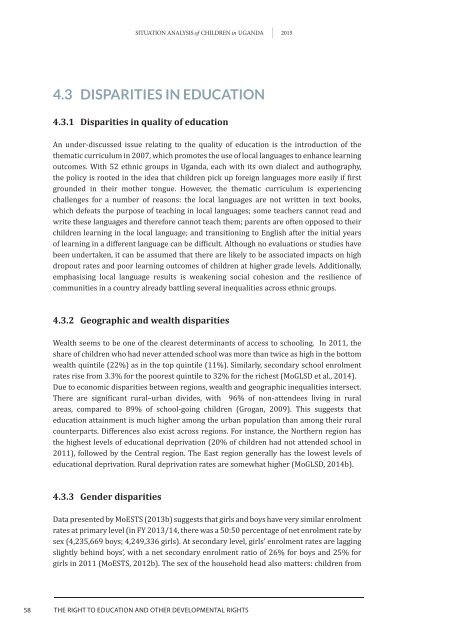Situation analySiS
1TNu802
1TNu802
Create successful ePaper yourself
Turn your PDF publications into a flip-book with our unique Google optimized e-Paper software.
<strong>Situation</strong> <strong>analySiS</strong> of Children in uganda 20154.3 DISPARITIES IN EDUCATION4.3.1 Disparities in quality of educationAn under-discussed issue relating to the quality of education is the introduction of thethematic curriculum in 2007, which promotes the use of local languages to enhance learningoutcomes. With 52 ethnic groups in Uganda, each with its own dialect and authography,the policy is rooted in the idea that children pick up foreign languages more easily if firstgrounded in their mother tongue. However, the thematic curriculum is experiencingchallenges for a number of reasons: the local languages are not written in text books,which defeats the purpose of teaching in local languages; some teachers cannot read andwrite these languages and therefore cannot teach them; parents are often opposed to theirchildren learning in the local language; and transitioning to English after the initial yearsof learning in a different language can be difficult. Although no evaluations or studies havebeen undertaken, it can be assumed that there are likely to be associated impacts on highdropout rates and poor learning outcomes of children at higher grade levels. Additionally,emphasising local language results is weakening social cohesion and the resilience ofcommunities in a country already battling several inequalities across ethnic groups.4.3.2 Geographic and wealth disparitiesWealth seems to be one of the clearest determinants of access to schooling. In 2011, theshare of children who had never attended school was more than twice as high in the bottomwealth quintile (22%) as in the top quintile (11%). Similarly, secondary school enrolmentrates rise from 3.3% for the poorest quintile to 32% for the richest (MoGLSD et al., 2014).Due to economic disparities between regions, wealth and geographic inequalities intersect.There are significant rural–urban divides, with 96% of non-attendees living in ruralareas, compared to 89% of school-going children (Grogan, 2009). This suggests thateducation attainment is much higher among the urban population than among their ruralcounterparts. Differences also exist across regions. For instance, the Northern region hasthe highest levels of educational deprivation (20% of children had not attended school in2011), followed by the Central region. The East region generally has the lowest levels ofeducational deprivation. Rural deprivation rates are somewhat higher (MoGLSD, 2014b).4.3.3 Gender disparitiesData presented by MoESTS (2013b) suggests that girls and boys have very similar enrolmentrates at primary level (in FY 2013/14, there was a 50:50 percentage of net enrolment rate bysex (4,235,669 boys; 4,249,336 girls). At secondary level, girls’ enrolment rates are laggingslightly behind boys’, with a net secondary enrolment ratio of 26% for boys and 25% forgirls in 2011 (MoESTS, 2012b). The sex of the household head also matters: children from58 thE rIGht to EDUCatIoN aND othEr DEvELoPMENtaL rIGhtS




